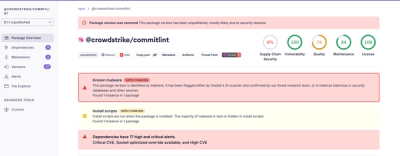
Research
Malicious fezbox npm Package Steals Browser Passwords from Cookies via Innovative QR Code Steganographic Technique
A malicious package uses a QR code as steganography in an innovative technique.
fragment-shader
Advanced tools
A lightweight & highly performant WebGL fragment shader renderer written in TypeScript.
3kb.Hello World section for details on all default behaviors.npm install --save fragment-shader
Note: there are several plugins in modern IDEs (VSCode, etc.) that enable GLSL (shader language) syntax highlighting within template literals by prefacing them with
/*glsl*/– doesn't seem to work on GitHub though.
import { Shader } from 'fragment-shader';
const glsl = /*glsl*/ `
void main () {
gl_FragColor = vec4(.8, .2, .7, 1.);
}
`;
const shader = new Shader(glsl);
The above code example instantiates an instance of the Shader class and passes it but a single paramter: a string containing your fragment shader code. By default, the Shader class will instantiate a <canvas> element and append it directly to the <body>. The <canvas> will then be sized to match the size of the browser window (and the display's pixel density). Given the default configuration value of fillViewport being true, An event listener is then created for the resize event on the browser window, allowing the renderer and its <canvas> to resize according to the browser window changing size or orientation. Then, after bootstrapping a webgl2 rendering context, it prepares all internals (including compiling your shader) before finally initializing an internal requestAnimationFrame loop, syncing the rendering animation to the native refresh rate of the display. There are two methods on the shader instance for controlling rendering playback:
// Cancel the `requestAnimationFrame` loop.
shader.stop();
// Resume the `requestAnimationFrame` loop.
shader.start();
If you wish for the renderer to behave differently than its default configuration, you can do so by passing the constructor a configuration object.
import { Shader } from 'fragment-shader';
const config: ShaderConfig = {
shader: /*glsl*/ `
void main () {
gl_FragColor = vec4(.8, .2, .7, 1.);
}
`,
target: document.body,
uniforms: [],
width: 800,
height: 600,
dpr: window.devicePixelRatio,
fillViewport: false,
onSuccess: () => {},
onError: () => {},
animate: false,
debug: false,
};
const shader = new Shader(config);
Or, if you become accustomed to the shader being the first argument of the constructor, you can instantiate this way:
import { Shader } from 'fragment-shader';
const config: ShaderConfig = { ... }
const shader = new Shader(/*glsl*/ `
void main () {
gl_FragColor = vec4(.8, .2, .7, 1.);
}
`, config);
Note If you set
animatetofalse, the shader will render its initial frame, but from thereon out you will be responsible for calling thetick()method on the Shader if you wish to update it – for example, within arequestAnimationFrameloop.
import { Shader } from 'fragment-shader';
const shader = new Shader(
/*glsl*/ `
void main () {
gl_FragColor = vec4(.8, .2, .7, 1.);
}
`,
{ animate: false }
);
const tick = (now: DOMHighResTimeStamp) => {
requestAnimationFrame(tick);
shader.tick(now);
};
requestAnimationFrame(tick);
FAQs
This project owns three core features, each simplifying working with fragment shaders in the browser.
The npm package fragment-shader receives a total of 54 weekly downloads. As such, fragment-shader popularity was classified as not popular.
We found that fragment-shader demonstrated a not healthy version release cadence and project activity because the last version was released a year ago. It has 1 open source maintainer collaborating on the project.
Did you know?

Socket for GitHub automatically highlights issues in each pull request and monitors the health of all your open source dependencies. Discover the contents of your packages and block harmful activity before you install or update your dependencies.

Research
A malicious package uses a QR code as steganography in an innovative technique.

Research
/Security News
Socket identified 80 fake candidates targeting engineering roles, including suspected North Korean operators, exposing the new reality of hiring as a security function.

Application Security
/Research
/Security News
Socket detected multiple compromised CrowdStrike npm packages, continuing the "Shai-Hulud" supply chain attack that has now impacted nearly 500 packages.